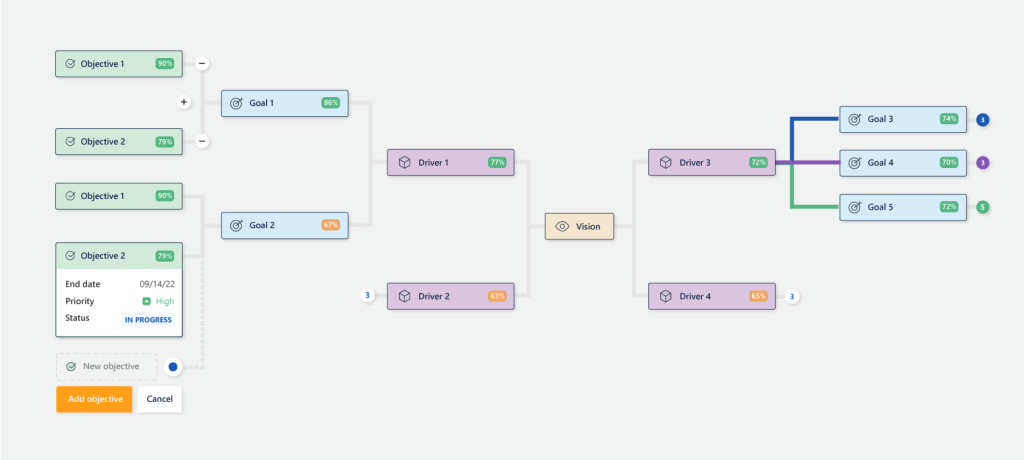What Is a Mind Map?
A mind map is an intuitive visual tool that helps organize ideas, concepts, and information in a structured, easy-to-understand format. It breaks down complex topics into smaller, interconnected components, making it easier to analyze relationships and generate insights. At its foundation, a mind map begins with a central concept that branches into subtopics and related ideas — forming a clear, connected visual framework.
For modern organizations, mind mapping is a powerful method for strategic planning and business alignment. It helps teams outline key objectives, track initiatives, and visualize how goals, actions, and outcomes relate to one another. Moreover, by offering a clear visual representation of strategy, mind maps allow leaders and teams to see the bigger picture while ensuring every individual effort aligns with the company’s overarching vision.

How Mind Maps Can Benefit Your Organization
In today’s fast-paced business environment, mind maps go far beyond simple brainstorming tools — they serve as a strategic asset that enhances clarity, collaboration, and decision-making across the organization. By visually connecting goals, initiatives, and outcomes, mind mapping transforms complex strategies into structured, actionable insights.
Here’s how mind maps can drive value within your organization:
-
Effortless Visualization: Mind maps simplify complex information, making it easier to see connections between key business drivers, objectives, and ongoing projects.
-
Improved Collaboration: Teams can use mind mapping tools to align around shared strategies, minimize miscommunication, and encourage more cohesive teamwork.
-
Enhanced Decision-Making: With a holistic view of internal operations and external factors — including markets, technology, and customer needs — leaders can quickly identify actionable insights and strategic opportunities.
-
Real-Time Insights: Mind maps provide continuous visibility into project progress, enabling real-time updates that streamline both planning and reporting processes.
-
Accountability and Alignment: From executives to frontline employees, everyone can clearly understand how their contributions support broader business goals, strengthening ownership and cross-functional collaboration.
Ultimately, mind mapping for business strategy empowers organizations to stay agile, transparent, and aligned — turning abstract ideas into measurable results.
The Basics of Mind Mapping
Mind mapping is an effective technique for breaking down an organization into its core components — from strategic drivers to actionable projects. By visually connecting these elements, mind maps help leaders understand how internal and external forces influence overall business strategy and execution.
Here’s a quick overview of the key components within a mind map for strategic planning:
-
Drivers: The internal factors (such as mission, policies, and team dynamics) and external influences (like competition, regulations, and market trends) that shape the organization’s strategic direction.
-
Goals: Broad, long-term business objectives, both financial and non-financial, typically set over a 3–5-year period to guide sustainable growth.
-
Objectives: Specific, measurable milestones tied to each goal, designed to track progress and performance over shorter timeframes.
-
Projects: Concrete initiatives or activities executed to achieve aligned goals and objectives, driving real business outcomes.
By mapping these components, professionals can clearly visualize the interactions and dependencies between them. As a result, mind maps make it easier to design well-structured, data-driven, and effective business strategies that enhance clarity, focus, and alignment across the organization.
Building an Effective Mind Map
Creating an effective mind map is both an art and a strategy. When designed thoughtfully, it becomes a powerful tool for strategic planning, helping teams visualize complex relationships, align priorities, and make informed decisions. Follow these steps to build a mind map that enhances clarity and drives organizational impact:
-
Define Your Central Concept:
Begin by identifying the core idea or strategic focus of your mind map — such as “Streamlining the Supply Chain” or “Marketing Strategy 2024.” Place this concept at the center to serve as the anchor for all related ideas. -
Brainstorm Related Topics:
Next, collaborate with your team to generate connected themes, drivers, challenges, and opportunities. Think broadly, then group similar concepts to maintain a structured flow. This step ensures your mind mapping process captures both high-level strategy and operational details. -
Connect the Dots:
Draw lines or arrows to connect subtopics back to the central node and to one another. This creates a logical, easy-to-navigate structure that visually represents how different elements of your strategy interrelate. -
Add Visual Enhancements:
Use colors, icons, and shapes to distinguish between themes like goals, risks, and priorities. These visual cues not only make your mind map more engaging but also help highlight critical areas for focus or improvement. -
Collaborate and Refine:
Effective mind mapping for teams thrives on collaboration. Encourage diverse input from departments and stakeholders during brainstorming sessions. With digital mind mapping tools, teams can collaborate seamlessly — even across remote locations — ensuring every perspective contributes to the strategy. -
Regularly Update the Map:
A mind map should evolve as your organization grows. Continuously refine and update it to reflect new insights, changing objectives, or shifting market conditions. This keeps your strategic mind map current and actionable.
Mind Mapping with Core-Strategy
Using Core-Strategy, organizations can take mind mapping to the next level. This enterprise-grade strategy management tool helps companies create mind maps that align drivers, goals, and objectives in real-time. Features like role-based strategy views and live progress tracking enable dynamic decision-making and effective strategy execution.
- Dynamic Strategy Maps : Visualize the relationships between drivers, goals, and projects for a clear understanding of the overarching strategy.
- Real-Time Status Insights: No more outdated slide decks or email trails. Core-Strategy provides instant visibility into initiative progress.
- Enhanced Collaboration: Ensure internal and external stakeholders are aligned through clear, accessible strategic visuals.
Why Mind Maps Elevate Strategic Thinking
Mind maps simplify complexity and provide clarity in strategic planning by visualizing links between factors and breaking down silos. They empower leaders to think critically and adapt swiftly to changes in both the internal and external business environment.
Advantages of Using Mind Maps for Enterprise Strategy
- Streamlined Collaboration: Mind maps foster alignment across teams, improving communication and ensuring everyone understands their role in the strategy.
- Real-Time Reporting: Ditch outdated tools and enable seamless status updates with centralized, real-time progress tracking.
- Improved Decision-Making: By synthesizing all relevant factors in one visual layout, mind maps enhance strategic thinking and help decision-makers identify actionable insights.
- Elimination of Siloed Thinking: Encourage interconnected, collaborative efforts across departments to achieve organizational goals more effectively.
Transform the Way You Strategize
Mind maps can revolutionize how your organization builds and communicates strategies. Whether you’re tackling a new initiative or scaling operations, seamless alignment and clarity can make all the difference. With Core-Strategy, unlocking the full potential of enterprise mind mapping is easier than you think. Take the first step toward smarter strategic planning today.
Sign up for a no-obligation trial and experience real-time strategy mapping with Core-Strategy’s advanced tools!
About Core-CSI
Core-Cyber Security Integrators (Core-CSI) offers trusted and results-driven services in Program/Project Management, Enterprise Architecture, Business Process Re-engineering, and Cybersecurity. For over a decade, Core-CSI has supported enterprises, from federal agencies to commercial organizations, with cutting-edge strategy tools and insights.
Proprietary Information© 2022 Core-CSI LLC All Rights Reserved


